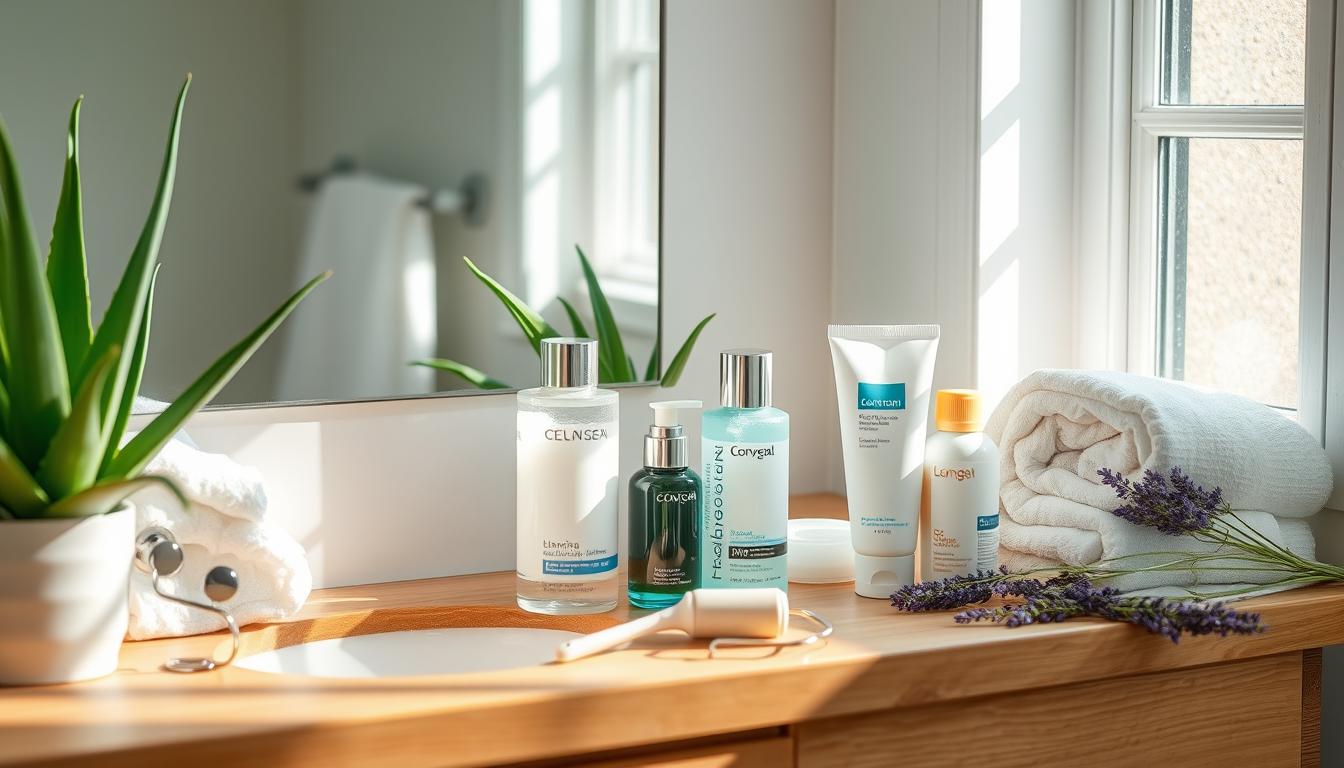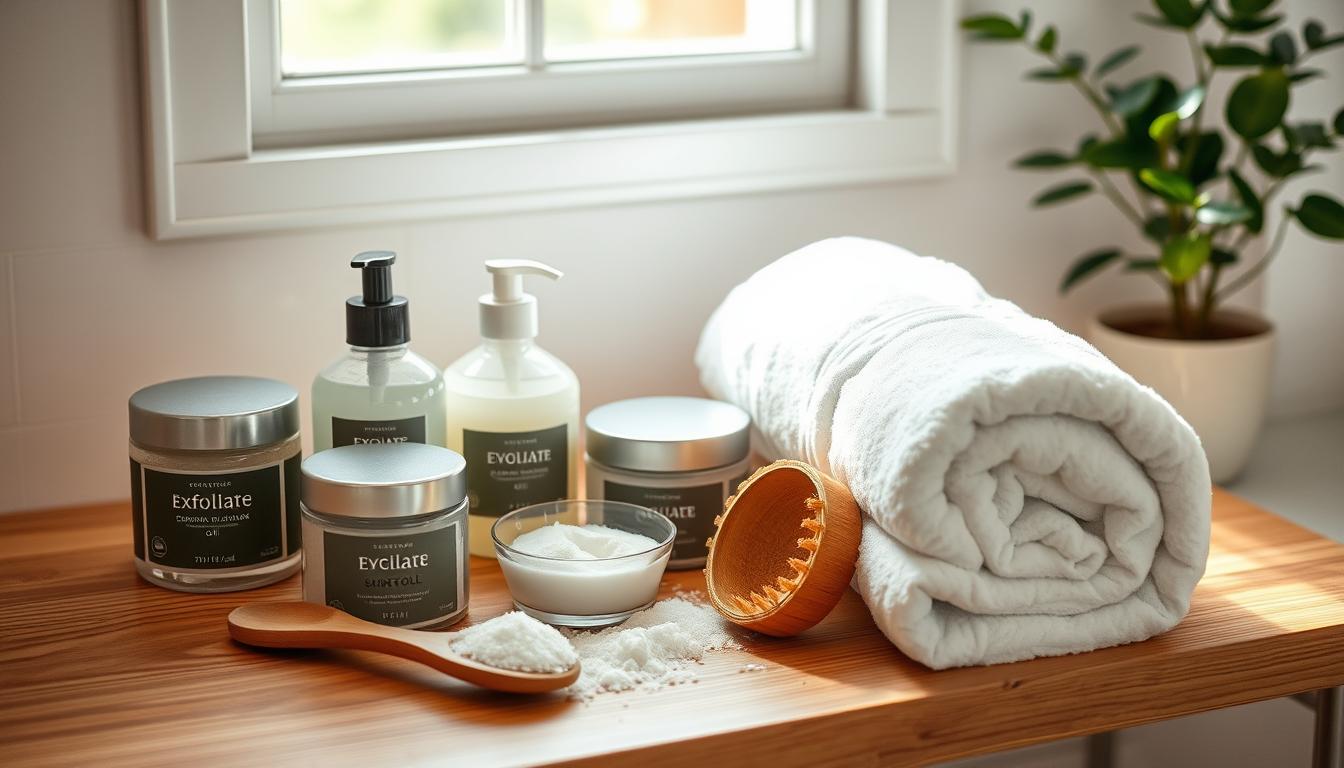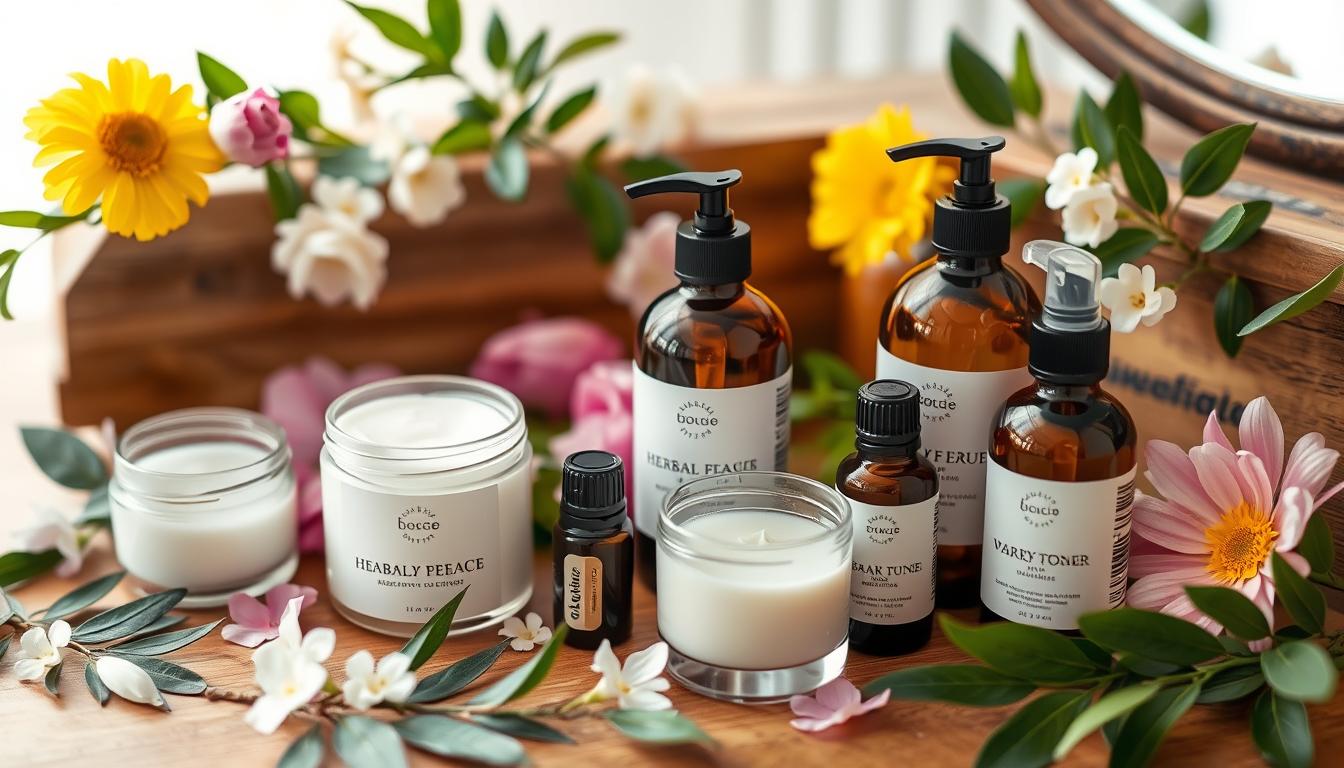Getting and keeping healthy, glowing skin is a journey. It needs a consistent, personal skincare plan. Your skin is special, and what works for others might not be right for you. By knowing the key steps of a good skincare routine, you can make it fit your skin’s needs. This way, you can get a brighter, younger-looking skin.
Key Takeaways
- A consistent skincare routine is essential for maintaining healthy, glowing skin.
- Understanding your skin type is the foundation for building an effective skincare regimen.
- Proper cleansing, exfoliation, toning, and moisturizing are crucial steps in any skincare routine.
- Incorporating sun protection and targeted serums can enhance your skincare results.
- Adjusting your routine seasonally and seeking professional help when needed can optimize your skin’s health.
Understanding Your Skin Type
Finding out your skin type is key to a good skincare routine. Knowing what your skin needs helps you pick the right personalized skincare products. By figuring out your skin type, you can make sure your daily skincare meets your needs. This helps you get healthier, more glowing skin.
Importance of Skin Type in Skincare
Your skin type affects what products and methods work best for you. Different skin types need different levels of moisture, oil control, and treatments. Tailoring your skincare routine to your skin type makes it more effective. It also helps you tackle specific skin issues better.
How to Identify Your Skin Type
Finding out your skin type is easy with a simple test or a pro’s help. Here are ways to figure out your skin type:
- Visual assessment: Look at your skin – is it dry, oily, or a mix? Check for redness, flakiness, or shine.
- Touch test: Gently press your skin with a tissue or clean cotton pad. If it’s oily, you might have oily or combo skin. If it’s dry, you likely have dry skin.
- Professional consultation: See a dermatologist or skincare expert for a detailed skin check. They can give you personalized advice for your skincare routine.
After figuring out your skin type, you can customize your personalized skincare to meet your needs. This leads to healthier, more radiant skin.
The Role of Cleansing in Your Routine
Cleansing is key to a good skincare routine. It removes dirt, oil, and makeup, getting your skin ready for more steps. Picking the right facial cleanser and learning how to use it well can greatly improve your skin’s health and look.
Choosing the Right Cleanser
Choosing a cleanser depends on your skin type. If you have oily or acne-prone skin, a foaming or gel cleanser is best. It helps control oil and clear pores. Dry or sensitive skin does better with creamy or milk cleansers, as they are softer and keep moisture in.
For combination skin, a balanced, pH-neutral cleanser is best. It won’t dry out your skin.
Cleansing Techniques for Different Skin Types
How you clean your skin matters too. For normal to dry skin, use a gentle, circular motion to clean without drying out. Oily or acne-prone skin might need a soft-bristled brush or device for a deeper clean. But be gentle.
Sensitive skin should avoid harsh scrubbing. Instead, use a light, patting motion to clean.
It’s important to remove makeup, sunscreen, and other products before bed, no matter your skin type. Leaving them on can clog pores and cause breakouts. So, make sure to cleanse well every night as part of your skincare routine.
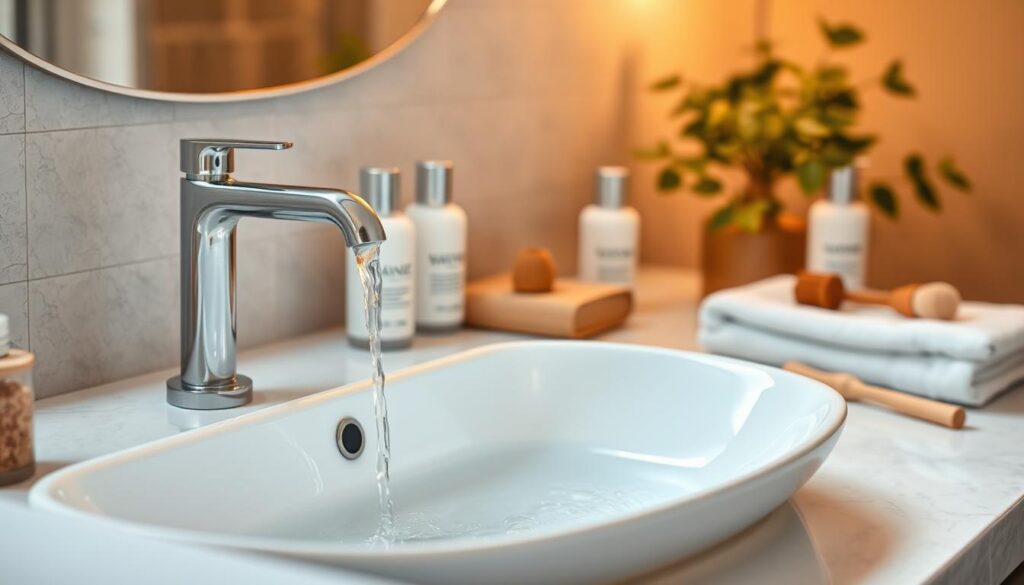
Understanding cleansing and choosing the right facial cleanser and method for your skin type is crucial. It sets the stage for a healthy, glowing complexion. Consistent and proper cleansing is the first step to reaching your skincare goals.
Exfoliation: Why It Matters
Exfoliation is key in any good skincare routine. It removes dead skin cells, dirt, and debris. This lets other skincare products work better and makes your skin look brighter and more radiant.
Regular exfoliation helps keep your skin healthy. It’s about new cells forming and old ones being shed. This process is called skin cell turnover.
Chemical vs. Physical Exfoliants
You can choose between chemical and physical exfoliants. Chemical exfoliants, like alpha-hydroxy acids (AHAs) and beta-hydroxy acids (BHAs), break down dead skin cells. Physical exfoliants, like exfoliating scrubs and brushes, remove dead skin cells through gentle rubbing.
Choosing between chemical and physical exfoliants depends on your skin and what you prefer. Chemical exfoliants are gentler and better for sensitive skin. Physical exfoliants are more invigorating and good for tougher skin.
How Often Should You Exfoliate?
How often you exfoliate depends on your skincare routine steps and skin type. Here’s a general guide:
- Normal to dry skin types: Exfoliate 1-2 times per week
- Oily or acne-prone skin types: Exfoliate 2-3 times per week
- Sensitive skin types: Exfoliate 1 time per week or every other week
Start with a lower frequency and increase as your skin gets used to it. Exfoliating too much can irritate your skin and disrupt its natural barrier. Always listen to your skin and adjust your routine as needed.
“Exfoliation is the key to a healthy, glowing complexion. It’s an essential step that shouldn’t be overlooked in your skincare routine.”
The Benefits of Toners
Toners are key in a good skincare routine. They help keep your skin healthy and balanced. These liquids prepare your skin for other products, restoring the skin’s natural pH and improving absorption.
Types of Toners and Their Benefits
There are many types of toners, each for different skin needs. Hydrating toners add moisture, making your skin soft. Exfoliating toners remove dead skin cells, unclog pores, and smooth out your skin.
Treatment toners tackle specific issues like skin pH balance, reducing pores, or fighting aging signs.
How to Incorporate Toners into Your Routine
Adding a toner to your daily skincare routine steps is easy and effective. Use a cotton pad or your hands to apply it after cleansing. This step removes extra dirt, calms your skin, and gets it ready for more products.
Choose to use a toner morning and night, or just once a day, based on your skin type and needs.
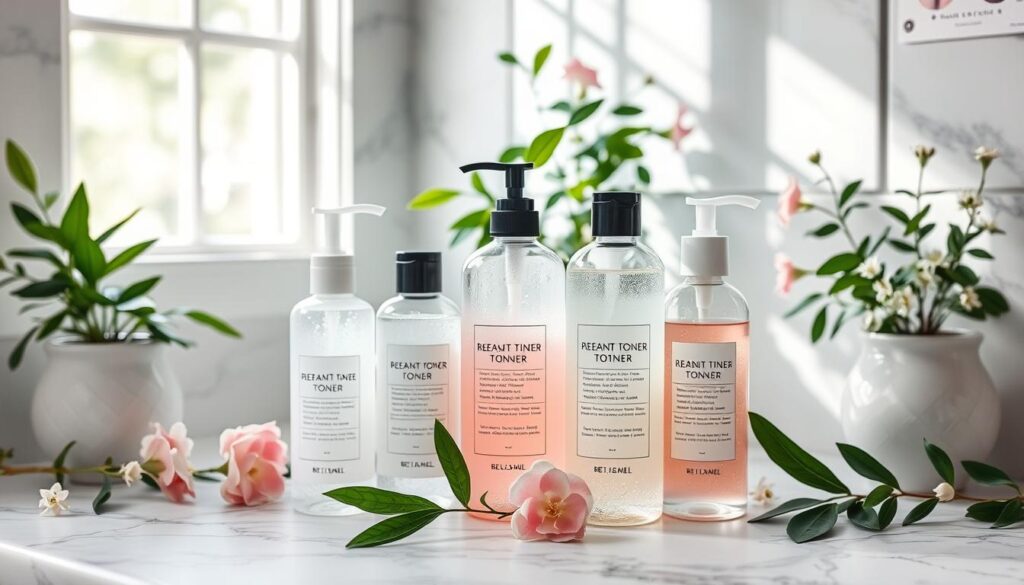
Consistency is important when using toners and other skincare products. By making toners a regular part of your skincare routine steps, you can see the benefits of healthy, balanced skin.
Moisturizing: Keeping Your Skin Hydrated
Keeping your skin hydrated is key for its health and look. Moisturizing is a must in any skincare routine. It keeps moisture in, strengthens the skin, and stops dryness and irritation.
Finding the Perfect Moisturizer for Your Skin
Choosing the right moisturizer depends on your skin type. If you have oily skin, go for lightweight, oil-free ones. Dry skin does well with richer, more emollient moisturizers. Sensitive skin needs gentle, fragrance-free options to avoid irritation.
Look at the ingredients in your moisturizer. Hyaluronic acid, glycerin, and ceramides are good for locking in moisture and supporting the skin’s barrier.
Day vs. Night Moisturizers: What to Know
Your skin’s needs change during the day and night. Using different moisturizers for each time can be helpful. Day moisturizers have SPF to protect from the sun. Night moisturizers focus on repair and rejuvenation.
- Day moisturizers: Lightweight, oil-free formulas with SPF to defend against sun damage.
- Night moisturizers: Richer, more emollient formulas that deeply hydrate and support skin’s natural regeneration.
Using both day and night moisturizers keeps your skin hydrated and healthy all day and night.
| Day Moisturizer | Night Moisturizer |
|---|---|
| Lightweight formula | Richer, more emollient formula |
| Contains SPF for sun protection | Focuses on skin repair and regeneration |
| Suitable for all skin types | Tailored to individual skin needs |
Understanding your skin’s needs and using both day and night moisturizers helps keep it hydrated. This supports your skin’s health and vitality.
Sun Protection: A Skincare Essential
Sun exposure can cause premature aging, wrinkles, and even skin cancer. It’s vital to add sun protection to your daily skincare routine. Daily sunscreen use is key to keeping your skin healthy and young-looking. It protects your skin from harmful UV radiation, even on cloudy days.
Importance of Daily Sunscreen Use
Sunscreen is your skin’s first defense against the sun’s harmful rays. Using a broad-spectrum sunscreen with an SPF of 30 or higher daily can lower your risk of sunburns and skin damage. It’s crucial for preventing premature aging and skin cancer.
Types of Sunscreens: Chemical vs. Physical
Sun protection comes in two main types: chemical and physical. Chemical sunscreens absorb UV radiation, while physical sunscreens reflect and scatter it. Each has its own benefits and is best for different skin types:
- Chemical Sunscreens: These use ingredients like avobenzone and oxybenzone to absorb UV rays. They are lightweight and easy to apply, making them less visible on the skin.
- Physical Sunscreens: Known as mineral sunscreens, they use zinc oxide and titanium dioxide to reflect UV rays. They are great for sensitive skin and offer broad-spectrum protection.
Choosing between chemical and physical sunscreens depends on your skin type and needs. It’s important to try different options to find the best sun protection for you.
Incorporating Serums in Your Routine
Adding serums to your skincare routine can change the game. Serums are strong, focused treatments for your skin. They help with hydration, brightening, anti-aging, and controlling blemishes.
What are Serums and Their Benefits?
Serums are light, packed with active ingredients. They go deep into your skin, unlike moisturizers. Serums can do many things, like:
- Make your skin more hydrated and plump
- Lessen the look of fine lines and wrinkles
- Give you a brighter, more even skin tone
- Help with acne, dark spots, or other skin problems
How to Layer Serums for Best Results
To use serums right, follow a few steps. This ensures you get the most out of them. Here’s how to layer them:
- Clean your skin well to get rid of dirt or leftover products.
- Put on your serums from lightest to heaviest. Start with water-based, then oil-based or thicker ones.
- Let each serum soak in before adding the next one.
- End with a moisturizer to keep the serum’s benefits in.
Keep in mind, the right order and mix of serums depends on your skin. Try different ways to find what works best for you.
“Adding serums to your routine is a simple yet effective way to target specific skin concerns and take your skincare to the next level.”
Targeting Specific Skin Concerns
Getting healthy, glowing skin is not a one-size-fits-all deal. You need to focus on your specific skin issues. Whether it’s fighting acne or reducing aging signs, the right treatments and products can help a lot.
Dealing with Acne Breakouts
Acne can be tough to deal with, but the right skincare can help. Look for products with salicylic acid, benzoyl peroxide, and tea tree oil. Also, exfoliating gently can help keep pores clear.
- Avoid harsh, drying products that can further irritate acne-prone skin.
- Incorporate a clay mask into your routine to deeply cleanse and purify pores.
- Prioritize moisturizing to maintain a healthy skin barrier and prevent excess oil production.
Solutions for Anti-Aging and Fine Lines
As we age, our skin loses elasticity and collagen. This leads to fine lines and wrinkles. Use products with retinol, vitamin C, and alpha hydroxy acids. They help with cell turnover, collagen, and smoothing wrinkles.
- Incorporate a retinol serum into your nighttime routine for enhanced cell renewal.
- Use a vitamin C-infused moisturizer during the day to brighten and protect your skin.
- Consider adding a weekly glycolic acid peel to your regimen for a more radiant, youthful complexion.
Everyone’s skin is different, so what works for one might not work for another. Listen to your skin and try different products and treatments. If you have ongoing skin issues, talk to a skincare expert.
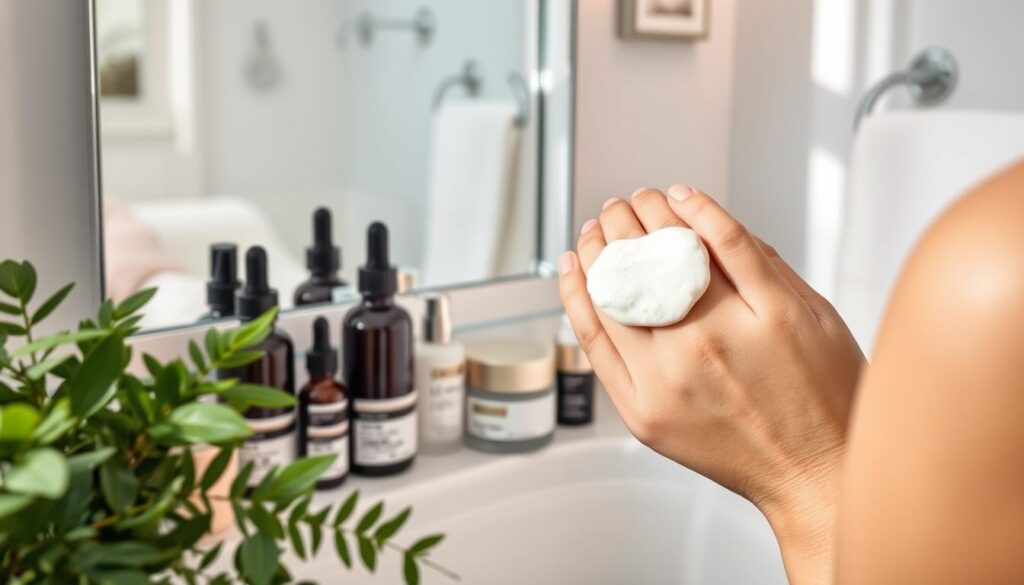
The Importance of Consistency
Creating a consistent skincare routine is vital for healthy, glowing skin. It helps your skin get used to the best products and care for it. By sticking to a routine, you’ll see your skin progress improve slowly but surely.
How Often Should You Follow Your Routine?
To get the best results, follow your skincare routine twice a day. Do it once in the morning and once at night. This keeps your skin well-cared for all day and night. Skipping steps can mess up your routine and slow down your skin’s progress.
Tracking Changes and Results Over Time
- Keep a skincare journal or log to document your skin progress and observe the changes over time.
- Take regular photos of your skin to visually track the improvements in texture, tone, and overall appearance.
- Pay attention to how your skin responds to the products and adjustments you make to your skincare routine.
- Be patient and consistent, as it can take several weeks or even months to see the full benefits of your routine.
Being consistent in your skincare routine is key to reaching your skin goals. By sticking to a routine and tracking your skin progress, you can refine your care and keep your skin looking its best.
Nighttime Skincare Routine Essentials
As the day ends, your skin needs a special nighttime routine to heal and refresh. At night, your skin is in repair mode. It’s the best time to fix specific skin problems and help it glow.
Key Products for Night Use
For a good nighttime skincare plan, you need a few key items:
- Retinoids: These strong ingredients, like retinol, boost skin cell renewal. They also lessen fine lines, wrinkles, and acne.
- Intensive Treatments: Use serums or masks at night. They have more active ingredients to solve specific skin problems.
- Hydrating Moisturizers: Choose creams or lotions that deeply nourish and keep moisture in. They help fix the skin’s barrier while you sleep.
Why Nighttime is Crucial for Skin Repair
While you sleep, your skin works hard to fix itself. It repairs damage, adds moisture, and gets ready for the next day. That’s why a good skincare routine steps at night is key.
Your skin is most open to treatments at night. This means it can soak up and use them better. By focusing on nighttime skincare, you help your skin repair itself. This leads to a healthier, brighter look.
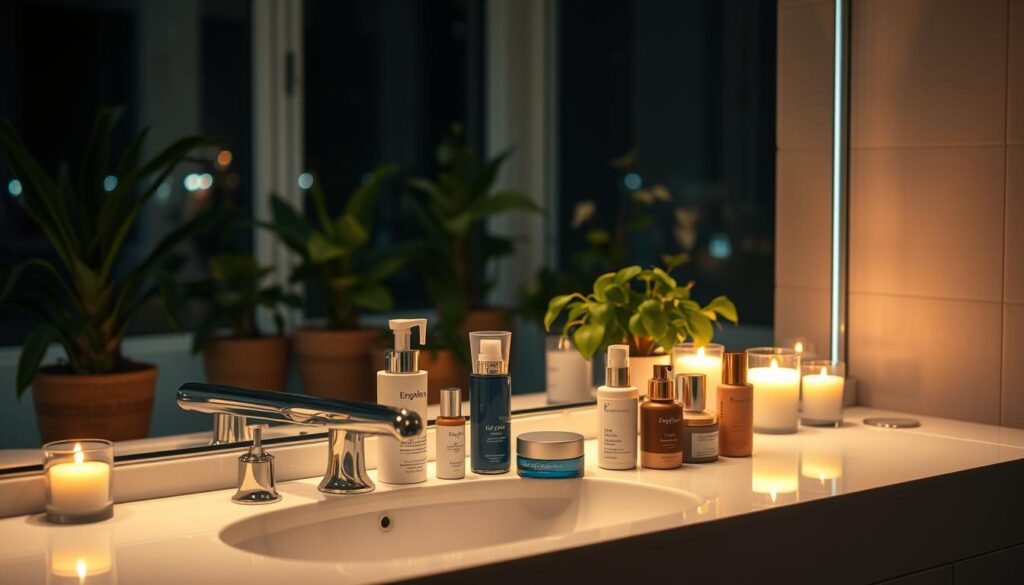
“Consistent nighttime skincare is essential for maintaining healthy, youthful-looking skin. It’s during the night when your skin’s repair and rejuvenation processes are at their peak.”
| Nighttime Skincare Product | Purpose | Skin Type Recommendation |
|---|---|---|
| Retinoids | Improve skin cell turnover, reduce fine lines and wrinkles, address acne | Suitable for most skin types, including sensitive skin when introduced gradually |
| Intensive Treatments | Target specific skin concerns with higher concentrations of active ingredients | Varies based on skin type and concern, choose formulas accordingly |
| Hydrating Moisturizers | Provide deep nourishment and lock in moisture for skin repair | Ideal for dry and combination skin types, but can be used across all skin types |
Adjusting Your Routine with Seasonal Changes
As the seasons change, so do your skin’s needs. It’s important to adjust your skincare routine to match the environment. This ensures your skin stays healthy and radiant all year.
Temperature and humidity levels change with each season. These changes can deeply affect your skin’s skin adaptation and health.
How Different Seasons Affect Your Skin
In the cold months, your skin gets drier and more sensitive. This is because of lower humidity and harsh winds. On the other hand, summer’s warmth and humidity can make your skin produce more oil. This can lead to more breakouts.
Knowing how seasonal skincare impacts your skin is key. It helps you create a good skincare routine steps for your skin type.
Tips for Seasonal Skincare Adjustments
- Switch to a richer, more emollient moisturizer in the winter to combat dryness.
- Incorporate a gentle, foaming cleanser in the summer to remove excess oil and dirt.
- Increase the frequency of exfoliation during the warmer months to unclog pores.
- Use a hydrating serum or face mask to replenish moisture in the cold, dry air.
- Adjust your sun protection based on the intensity of UV rays throughout the year.
By making smart changes to your skincare routine, you can keep your skin healthy all year. Remember, your skin is always adapting. Stay in tune with its needs and adjust as the environment changes.
When to Seek Professional Help
While a good skincare routine can do wonders, sometimes you need a pro’s help. If you’re dealing with ongoing skin problems or have concerns about your skin health, a dermatologist or skincare specialist can offer great advice. They can give you personalized solutions tailored just for you.
Signs It’s Time to Consult a Dermatologist
If your skincare routine isn’t fixing your skin issues, it’s time to see a dermatologist. Problems like severe acne, stubborn rosacea, or unexplained rashes need a doctor’s touch. They can figure out what’s wrong and create a plan to fix it.
Finding the Right Skincare Professional for You
Looking for a skincare pro? Look for board-certified dermatologists or licensed estheticians with lots of experience. Check their credentials, read reviews, and make sure they use treatments that fit your needs. A good expert can help you get the skin you want and keep it healthy for years.

